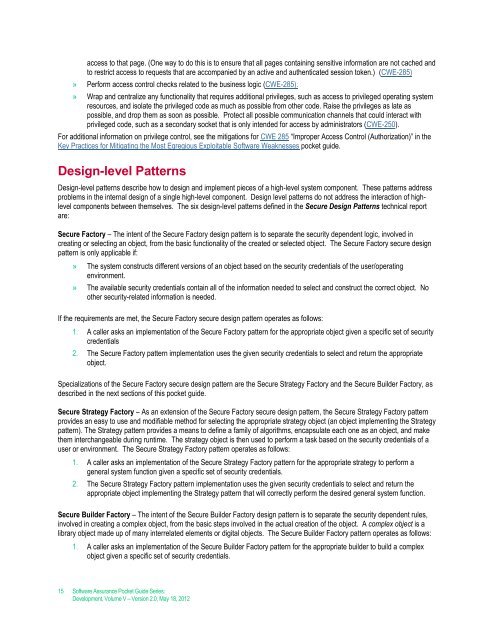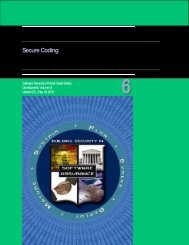Architecture and Design Considerations - Build Security In - US-CERT
Architecture and Design Considerations - Build Security In - US-CERT
Architecture and Design Considerations - Build Security In - US-CERT
Create successful ePaper yourself
Turn your PDF publications into a flip-book with our unique Google optimized e-Paper software.
access to that page. (One way to do this is to ensure that all pages containing sensitive information are not cached <strong>and</strong><br />
to restrict access to requests that are accompanied by an active <strong>and</strong> authenticated session token.) (CWE-285)<br />
» Perform access control checks related to the business logic (CWE-285).<br />
» Wrap <strong>and</strong> centralize any functionality that requires additional privileges, such as access to privileged operating system<br />
resources, <strong>and</strong> isolate the privileged code as much as possible from other code. Raise the privileges as late as<br />
possible, <strong>and</strong> drop them as soon as possible. Protect all possible communication channels that could interact with<br />
privileged code, such as a secondary socket that is only intended for access by administrators (CWE-250).<br />
For additional information on privilege control, see the mitigations for CWE 285 “Improper Access Control (Authorization)” in the<br />
Key Practices for Mitigating the Most Egregious Exploitable Software Weaknesses pocket guide.<br />
<strong>Design</strong>-level Patterns<br />
<strong>Design</strong>-level patterns describe how to design <strong>and</strong> implement pieces of a high-level system component. These patterns address<br />
problems in the internal design of a single high-level component. <strong>Design</strong> level patterns do not address the interaction of highlevel<br />
components between themselves. The six design-level patterns defined in the Secure <strong>Design</strong> Patterns technical report<br />
are:<br />
Secure Factory – The intent of the Secure Factory design pattern is to separate the security dependent logic, involved in<br />
creating or selecting an object, from the basic functionality of the created or selected object. The Secure Factory secure design<br />
pattern is only applicable if:<br />
» The system constructs different versions of an object based on the security credentials of the user/operating<br />
environment.<br />
» The available security credentials contain all of the information needed to select <strong>and</strong> construct the correct object. No<br />
other security-related information is needed.<br />
If the requirements are met, the Secure Factory secure design pattern operates as follows:<br />
1. A caller asks an implementation of the Secure Factory pattern for the appropriate object given a specific set of security<br />
credentials<br />
2. The Secure Factory pattern implementation uses the given security credentials to select <strong>and</strong> return the appropriate<br />
object.<br />
Specializations of the Secure Factory secure design pattern are the Secure Strategy Factory <strong>and</strong> the Secure <strong>Build</strong>er Factory, as<br />
described in the next sections of this pocket guide.<br />
Secure Strategy Factory – As an extension of the Secure Factory secure design pattern, the Secure Strategy Factory pattern<br />
provides an easy to use <strong>and</strong> modifiable method for selecting the appropriate strategy object (an object implementing the Strategy<br />
pattern). The Strategy pattern provides a means to define a family of algorithms, encapsulate each one as an object, <strong>and</strong> make<br />
them interchangeable during runtime. The strategy object is then used to perform a task based on the security credentials of a<br />
user or environment. The Secure Strategy Factory pattern operates as follows:<br />
1. A caller asks an implementation of the Secure Strategy Factory pattern for the appropriate strategy to perform a<br />
general system function given a specific set of security credentials.<br />
2. The Secure Strategy Factory pattern implementation uses the given security credentials to select <strong>and</strong> return the<br />
appropriate object implementing the Strategy pattern that will correctly perform the desired general system function.<br />
Secure <strong>Build</strong>er Factory – The intent of the Secure <strong>Build</strong>er Factory design pattern is to separate the security dependent rules,<br />
involved in creating a complex object, from the basic steps involved in the actual creation of the object. A complex object is a<br />
library object made up of many interrelated elements or digital objects. The Secure <strong>Build</strong>er Factory pattern operates as follows:<br />
1. A caller asks an implementation of the Secure <strong>Build</strong>er Factory pattern for the appropriate builder to build a complex<br />
object given a specific set of security credentials.<br />
15 Software Assurance Pocket Guide Series:<br />
Development, Volume V – Version 2.0, May 18, 2012
















